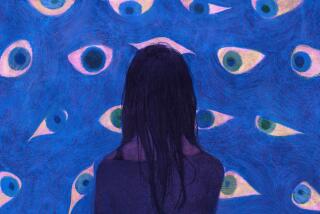Fake Eyeglasses for Fashion, the Look of Intellectualism
- Share via
Opticians and optometrists in Orange County and across the country report growing numbers of customers buying fake eyeglasses to appear intellectual--what Spy magazine calls “Faking Smart: The Importance of Looking Earnest.”
“I’m finding a lot of folks coming in with no prescription whatsoever, wanting eyeglasses to give them a certain look--the impact of greater intelligence or professionalism,” says Michael O’Leary, optician and manager of Dr. Leventhal’s Vision Care Centers of America at MainPlace/Santa Ana.
“And that’s exactly what we do is create an image for them,” he adds. “They say, ‘This is what I do for a living and this is what I need to look like; help me.’ ”
Spectacles are back in style and in hot demand as accessories in everything from rock videos to fashion layouts.
“We use glasses and sunglasses as accessories, the same way we use jewelry and shoes” to change looks, says Phyllis Posnick, fashion director of Vogue magazine. “It’s not a pseudo-intellectual look as far as we’re concerned,” she adds. “It’s just fashion.”
Across the country, frame sales are dramatically up too. Eugene Keeney, a spokesman for the Optical Manufacturers Assn., says sales have increased about 20% in the past few years, significant because historically, “sales were steady from year to year.”
“Now it’s taken off again,” he says, “because there’s so much variety in frame styles, probably.”
Not surprisingly, eyeglasses entrepreneur Barbara McReynolds traces the beginning of the brainy look back to the late 1970s when she and a partner opened a store on Melrose Avenue and later South Coast Plaza to sell avant-garde frames.
McReynolds--co-owner with Gai Gherardi of l.a. Eyeworks, whose ads depict the likes of Andy Warhol and Grace Jones wearing Eyeworks glasses--says frame styles were extremely limited before she and her partner began designing a line of high-fashion looks. Their designs now sell for $90 to $225.
The partners have built a reputation by outfitting the glitterati of Hollywood and by their ads featuring such celebrities as Pee Wee Herman, Arnold Schwarzenegger and Divine.
Eyeworks frames owned by Elton John were recently auctioned at Sotheby’s, and the company has designed several styles for movies, including those worn by Dustin Hoffman in his Academy Award-winning role in “Rain Man.”
“The trend has been slowly moving across the country since we opened . . . and approached the selling of glasses as if they were important fashion elements, which they are,” says McReynolds, who along with Gherardi grew up in Huntington Beach.
“We believe that if you wear glasses, the glasses are the fashion and the (clothes) are the accessories--whether you need to wear the glasses or not.”
The two frame designers, whose South Coast Plaza store opened last September, say today’s customer wants several different designs to achieve different looks.
“Now you can get color, interesting shapes and innovative designs,” McReynolds says. “And people who don’t need eyeglasses are buying them with clear lenses just to have the look.”
McReynolds says her most popular frames are classic shapes in sand-blasted or antique metal finishes and anodized aluminum frames in lime green or purple.
O’Leary, at Dr. Leventhal’s Vision Care in Santa Ana, says his most popular frames are the studious styles: “the preppy look, especially Ralph Lauren Polo frames, are the most popular right now,” he says. “It’s a smaller, rounder frame . . . in gold metal with tortoise shell overlay” for men and women. His frames cost between $49 and $400.
The specious spectacle phenomenon has been simmering in Hollywood and Manhattan for some time. The Wall Street Journal reported in 1987 that several Wall Street opticians were selling fake glasses to yuppies in search of a power look.
Vogue spotted the trend in California in 1986.
In Orange County, opticians and optometrists say that most customers are springing for stylish glasses because they need to wear them, although a growing segment is looking for fake eyeglasses.
O’Leary says fake eyeglasses account for about 10% of his business, adding that about 30% of his business comes from customers buying non-prescription contact lenses in various colors.
Peter Horvath, an optometrist with Eyestyles in Westminster, says most of his customers are looking for prescription lenses in high-fashion styles, from diamond-studded frames to neon colors. Those looking for frames with non-prescription lenses constitute about 5% of the business, he adds.
“Most of the time people want something that will work as a fashion accessory along with the function” of improving eyesight, he says. Eyestyles sells frames costing between $35 and $800.
Henry Shyer, past president of the Optical Manufacturers Assn., explains:
“When computers entered the scene, everybody wanted to look like an egghead and you can do that with glasses. But you can also have a glamour look, a high couture look or a businesslike, serious look.
“In fact, you can have an egghead look for lunch and a glamour look for dinner, if you want.”






